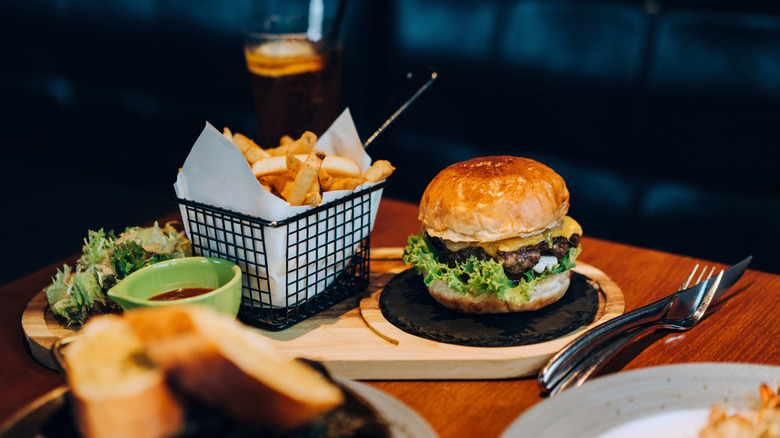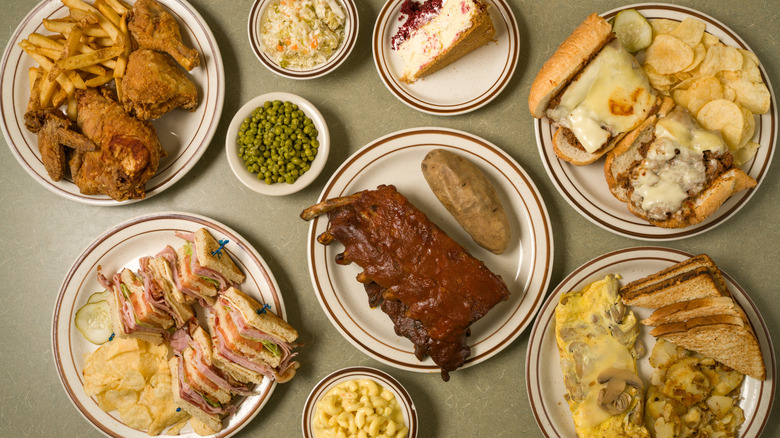Rick Steves Says That Italians Tend To Notice One Big Difference About Food In America
Suppose you asked native Italians what they think about "American food." What do you imagine these people would say? Given that authentic Italian restaurants are revered throughout the world, does this question even compute? When you picture the fresh tomatoes and mozzarella of a Caprese salad, the layered artistry of an old-country lasagna, or a masterfully prepared puttanesca, is there any item on the "classic American" menu that compares? Set against Italian pizza, which pizzaioli (pizza makers) have perfected since the Renaissance, won't the U.S. version always fall flat? Won't that go double for hamburgers, hot dogs, and all the other fast-casual platters we think of as "American"?
Rick Steves, the famed travel expert, hasn't found that to be the case. In a blog on his website, Steves recounts a conversation with Claudia, a tour guide in Rome who hails from Italy but has a great fondness for American cuisine. She loves the concept of going out for breakfast — which is rare in Italy — and savors stock favorites like BLT sandwiches. Later, Steves dines with friends from Tuscany, who speak lovingly of Buffalo wings. If you're expecting condescension and snobbery, Steves' anecdotes counter this stereotype: The Italians he knows have clearly sampled a good amount of American staples, and they've found much to enjoy.
Well, maybe too much. Their major critique is that U.S. portions are too big. "[Claudia] notes that in the US, size matters more than quality," writes Steves. In this case, "size" doesn't just mean Big Gulps and Super Size portions, but also extends to the complexity of the meals. "She says that the average number of ingredients in an American restaurant salad or pasta is eight or 10, while in Italy the average salad or pasta has only four or five ingredients."
Quality vs. quantity in American food
This observation will probably ring true if you're an American who has ever eaten at a restaurant in Europe. In addition to ingredients, the difference is also evident among libations: Europeans tend to pour water into tiny glasses, and it's rarely served with ice. You can't expect limitless refills of soft drinks as you can in the U.S., and France actually banned the practice in 2017. Tiny cups of coffee, especially espresso, are more popular in Europe; there's a reason these "shots" were diluted into the "Americano" during World War II — U.S. servicemen in Italy wanted the caffeine of an espresso but the volume of drip-coffee.
Rick Steves has waxed poetic about Italian cuisine before, noting the freshness of the ingredients and the romantic ambiance of true ristoranti; he's even argued that Italian-style restaurants in the U.S. can't compete with the ones in Italy. Fellow TV personality Stanley Tucci has noted the swiftness of Italian cooking — how very little is prepared in advance and stored in the kitchen, which amounts to a massive difference between U.S. and Italian food. Meanwhile, the Italian dessert gelato is lower in fat than most American ice creams; drinking wine with dinner and friends is much more widespread; and although "bars" are popular, libations are typically consumed in moderation.
Still, Steves' companions have a great love for American breakfasts. While Italians might sip coffee and nibble at a modest pastry, American diners serve mountainous portions, and this delights the Tuscans to no end. Steves' friend Monfredo even offers a toast to "bacon and eggs." Who knew the thing that would wow Mediterranean foodies could come in the form of a Denny's Grand Slam?

